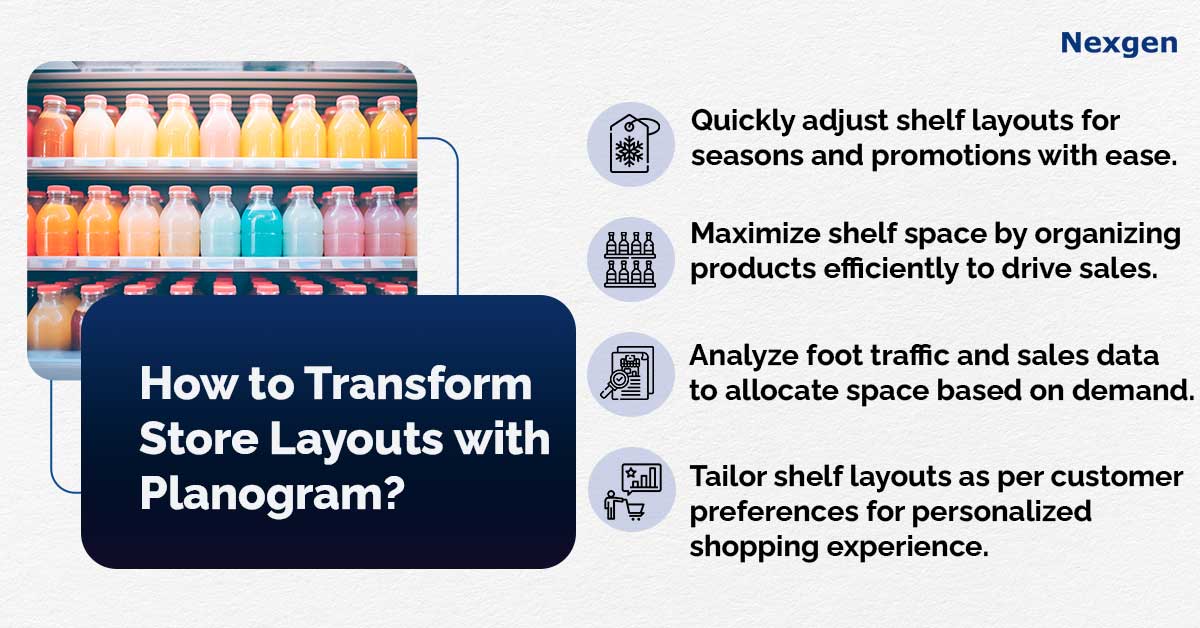Creating an efficient and customer-friendly store layout can be the difference between driving sales and losing them. One of the most effective tools to ensure your store’s layout is optimized for success is planogram. This visual merchandising tool helps retailers design, manage, and adjust their floor space to not only improve customer experience but also maximize revenue. Here is how planograms can transform your store layout and help you optimize your retail space.

Benefits of Planogram in Store Layouts
1. Maximizing space efficiency.
Retail space is a precious commodity, and planogram software helps you make the most of it. By analyzing foot traffic, sales data, and customer behavior, planograms allow retailers to allocate space based on demand and product profitability. Whether you are working with a large department store or a small boutique, planograms ensure that each shelf, display, and aisle is used efficiently to promote high-demand items.
2. Enhancing product visibility.
The right product placement can significantly impact sales. Planogram provides retailers with the ability to position products strategically to catch the attention of shoppers. For example, placing high-margin items at eye level can lead to increased visibility and, subsequently, higher sales. By using planograms, retailers can design their store layouts to guide customers naturally through the store, exposing them to a wider range of products.
3. Improving the customer journey.
A well-designed store layout encourages customers to spend more time browsing and shopping. Planogram helps retailers craft layouts that are easy to navigate and reduce bottlenecks, improving overall customer flow. This allows you to experiment with various layouts, test new configurations, and ensure your store is laid out in a way that aligns with shopper behavior and preferences.
4. Data-driven insights for continuous improvement.
One of the major advantages of planogram is the ability to make data-driven decisions. By analyzing sales data, inventory turnover, and customer interactions, planogram software can recommend layout changes in real-time to improve performance. These insights allow retailers to constantly refine their store layouts, adapting to the latest trends, seasonal changes, or shifts in customer preferences.
5. Supporting category management.
Planogram plays a critical role in category management by helping retailers balance product assortment, pricing, and merchandising strategies. It enables the visualization of different categories and subcategories, allowing store planners to ensure related products are placed together for easy discovery. This enhances the shopping experience and increases the likelihood of cross-selling and upselling opportunities.
Future of Planograms
The future of planogram is bright, with advancements like artificial intelligence (AI) and virtual reality (VR) offering even greater capabilities for retailers. AI-powered planograms can predict customer preferences and adjust layouts accordingly, while VR allows retailers to simulate store layouts in a virtual environment before making changes in the physical space. These technologies are set to revolutionize the way retailers approach space planning and visual merchandising, making it easier than ever to create optimized, customer-centric store layouts.
Overview of Nexgen POG
Nexgen POG is a robust and user-friendly cloud-based visual merchandising tool. It is designed for quick and efficient planogramming with minimal effort. Planogram in retail can be designed by easily dragging and dropping the products. The multi-device compatibility feature of POG allows you to obtain, share and edit planogram on any device, including your phone. It helps in designing store-specific planograms for increased product visibility and sales.
Get Your Free Trial Now!